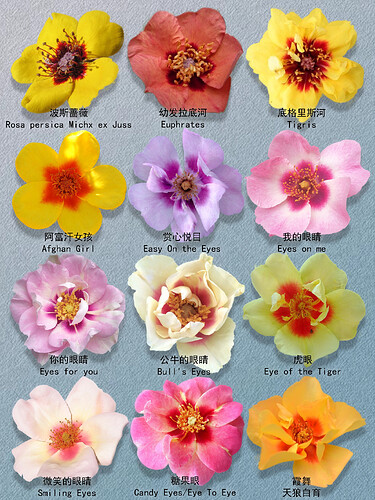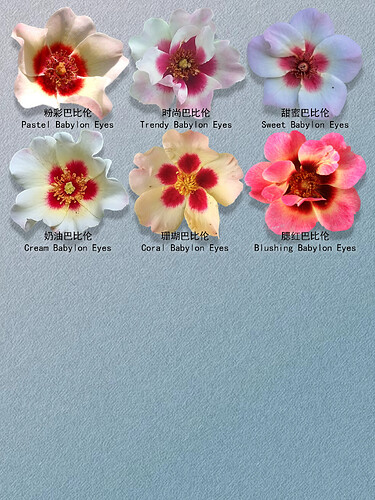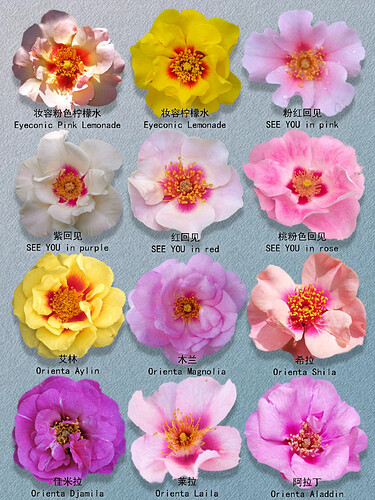I recently acquired Easy on the Eyes. This rose is removed by five generations from the species hulthemia. Thus, will its children have any chance of receiving the blotch, given this distance? In other words, is the blotch easily separated from hulthemias’ other traits (strange leaves, weedy habit) at this level of descent? I ask this because it is currently rather difficult to find hulthemia descendants in the US, and I wanted to know if a rose this far from the parent has any chance of passing on the trait.
Yes, it is possible–however, it has been difficult for me to get a decent population of seedlings using Easy on the Eyes as a parent (it’s probably triploid, and has stubbornly refused to produce any seeds for me so far). I did get one blotched seedling using its pollen; the blotch isn’t especially dark in this seedling’s case, but it is reasonable in size. I may continue to try using Easy on the Eyes to see if it can do even better, but you might want to look for a parent with higher fertility. You could try asking Burling Leong at Burlington Roses if she has any plants of Eyes for You on hand that she could sell.
Stefan
Hi @jwdykes
I wonder about this too.
There is an interesting discussion about blotch transmission here, although it is quite an old thread so perhaps there have been advances in blotchology since then:
https://forum.rosehybridizers.org/t/more-evidence-for-a-blotch-dose-effect-in-hulthemias/3405?u=seasiderooftop
Honestly, the problem largely boils down to not being able to find many hulthemias in the US. For example, the Orienta and Babylon series are only available in Europe, and the Eyeconic Series appears to have fallen out of common commerce (occasionally one will show up at my local gardening center). Any other ideas as to obtain additional hulthemias?
Thank you for posting that wonderful chart of the Hulthemia hybrids @Chio ! So nice to see them all in one place! The colors on these are very variable depending on temperature, and so is the size of the blotch. During our very hot summers the blotch pretty much vanishes.
@jwdykes I think there is still room for some experimentation to better understand some aspects of blotch transmission. As far as I understand from the conversation in the other thread, the blotch is apparently a dominant trait, but other things can interfere with it’s expression. Apparently, yellow color of the other parent is one of those things that can interfere, but I am not sure how definitive that is.
Regarding the Orienta series, there is still hope that they will be released in the US one day, since they are very recent Tantau introductions.
The Eyeconics and Babylons I would have less hope for since they are older releases, but based on the reviews on this forum, there were disease issues with many of them anyway, which may explain their disappearance.
In my humble opinion the new Tantau releases are very promising, healthy, compact (unlike the sprawling ground cover tendencies of say, Raspberry Kiss/Eyes on Me), and even a little fragrance. I imagine they will probably get renamed for introduction to the US though, apparently their names could be considered offensive over there.
I added Orienta Aylin late last year, adorable little rose, even though she doesn’t seem to want to set hips, I am trying her pollen right now and hope for some fertility.
Re the Babylons, some of them became the Sweet Spot series
So they kind of came and went, they weren’t particularly disease resistant for a lot of people which I think was a big part of why Tesselaar gave up on them after a couple years.
Tantau has very recently introduced a hulthemia landscape shrublet (Bienenweide Bernstein). I did not get it as it is not rated 4/4 fior blackspot, but I found it very interesting.It is probably a few generations away from the original Tigris, I guess
I have two hulthemia hybrids that really havent been talked much about here on the forum that i have for breeding. I have eyeconic mango lemonade and in your eyes. Both of these do great in my south carolina garden, however in your eyes does drop a lot of leaves at the end of the season. It does much better during the spring and summer. Both of these produce tons of hips. I used in your eyes as a pollen parent this year and have a seedling that is on the cusp of blooming. The seeds from in your eyes do not seem to want to germinate. I have yet to see how the mango lemonade does with pollen and seeds. I can give a report on passing the splotch on with these in here when i see more.
@Bregingew yes please, that would be very interesting to know about the offspring of in your eyes! Curious about who you used as seed parent for its pollen?
The poor germination seems to be a problem with some of these. It was already reported on this forum about Eyes on Me/Raspberry Kiss, and unfortunately I can confirm that myself, having not a single germination from Raspberry Kiss’ seeds this year.
@jac123 thank you so much for bringing that one up! I hadn’t heard of Bienenweide Bernstein , it looks very nice. It seems Tantau are the only ones coming out with new Hulthemias these days.
Wow. Did you grow all of these, Chio?
Hi Don,I only have a few of them.In my garden, there are almost all Austin roses
I only had few hulthemia hybrids available and since I was more interested in getting the blotch in one of my hybrids than testing the different hulthemia cultivars, I made a mix of their pollen. I put it on diverse hardy mothers and was very happy with the results. I had very good seed set on mothers that usually are reluctant for me and of those seedlings that have flowered I have had a reasonable proportion of flowers with the blotch. I have also had good seedlings that do not have the blotch and there is one that I think shows a lot of promise and I have started using in hybridization (with promising seedlings, but without blotch). The ones having blotch I have used for crossing seem to carry it further but I have not found a good seedling among the descendants.
Best wishes
Hjörtur
Hello Hjortur,
I was wondering if you could tell us which roses you have been successful with? Would be keen to play with some myself!
The first year I only had Tiger Eyes and Bright as a Button in the pollen mix. I had good results (lots of seed) with those but the seedlings with blotch were nothing to keep, most of the seedlings lost their vigour in the second year. I don’t think we can draw any conclusion on their suitability as parents because I had relatively few plants that germinated that year. The next two years I added Trendy Babylon Eyes, Fancy Babylon Eyes and Glorious Babylon Eyes to the mix and had better results blotch wise. I also had much better germination results and I have several seedlings from that mix that I am hoping I will be able to use for further breeding.
Best wishes
Hjörtur
I used Eyeconic, Eye of the Tiger, Fancy Babylon Sunset Babylon this year and a few do set buds very nice. I have some seeds popped last few weeks crossed with The Simple Life and a few others. I can add pictures when they start giving blooms.
they have introduced quite a lot of hulthemias in just a couple years, but I suspect that Kordes’ introduction may be better. They have scheduled the introduction of a new hulthemia, See You in Apricot, for 2024. I’m quite confident that both Tantau’s and Kordes’ hulthemias come from the “English line” of Hulthemias, probably the only way to go if blackspot resistance is one of the goals. The Babylon Eyes series, though easily available here, is not known to be particularly disease resistant. The overall look of the bloom is also different, Babylon Eyes tend to have a bolder appearance, with a darker blotch, and often two-toned background colour.
I got See You in Pink this winter, and I’m considering to get See You in Red too. See You in Pink got the ADR certification. It’s the first ADR Hulthemia I’m aware of, and it could be a very good sign for the development of the class. I’ve seen it for the first time in person last year in a garden center and the blotch was not especially dark (it was mid-summer, I think, so it may be darker in milder conditions), but added interest to the bloom.
Those are some gorgeous looking flowers in the See You series. Hopefully they eventually come to the US - the blackspot resistance would be great too, given that I’m in the South.
Kordes has a new series of roses called See You. The hybridizer Thomas Proll and I spoke in Australia and he said many of them are easy to breed with. Might be worth a try when they get to the US.
Blackspot resistance isn’t the worst in Easy on the Eyes, for what it’s worth–although certain of the hybrids descended from R. persica do also seem to handle summer dormancy well anyway. One additional problem I’ve found with it is that it tends to stop flowering for the summer, and often doesn’t bother to start up again in the fall, so it has behaved like a long once-bloomer. That’s pretty annoying if you’re expecting summer-long bloom in a climate with long, hot, humid summers, but the heat is also probably why it shuts down. Luckily, the other parent can help to overcome that in breeding to the extent that it is possible (since most roses reduce their flowering in the heat, if they don’t quit altogether). One problem with the blotch trait is that it can become less apparent–even virtually invisible–in the heat of summer, even if/when the rose does decide to bloom.
Both Easy on the Eyes and Eyes for You have pleasant fragrances, but none of the other available selections in the U.S. that I’ve tried so far have had a particularly pronounced scent. Can anyone comment on their experience of fragrance with selections available in Europe?
Stefan



